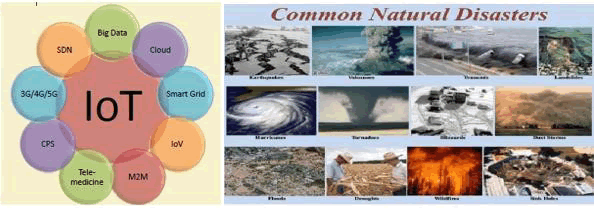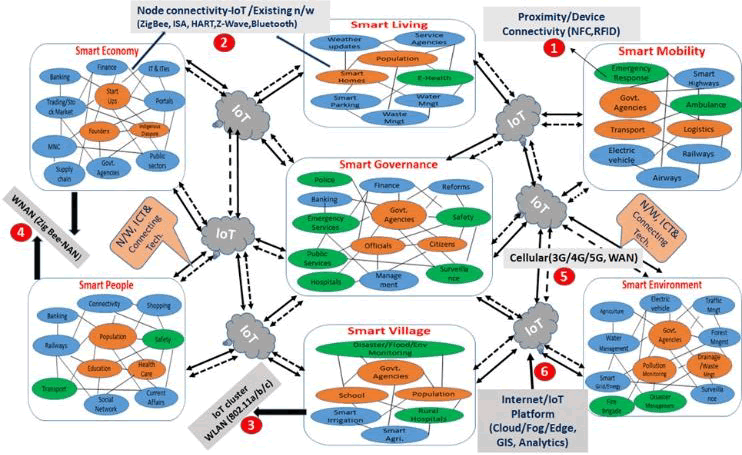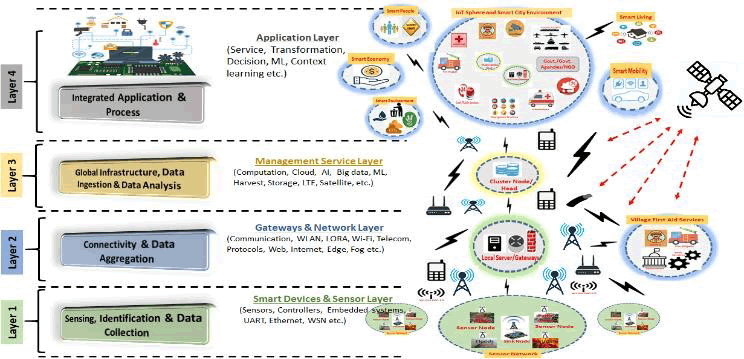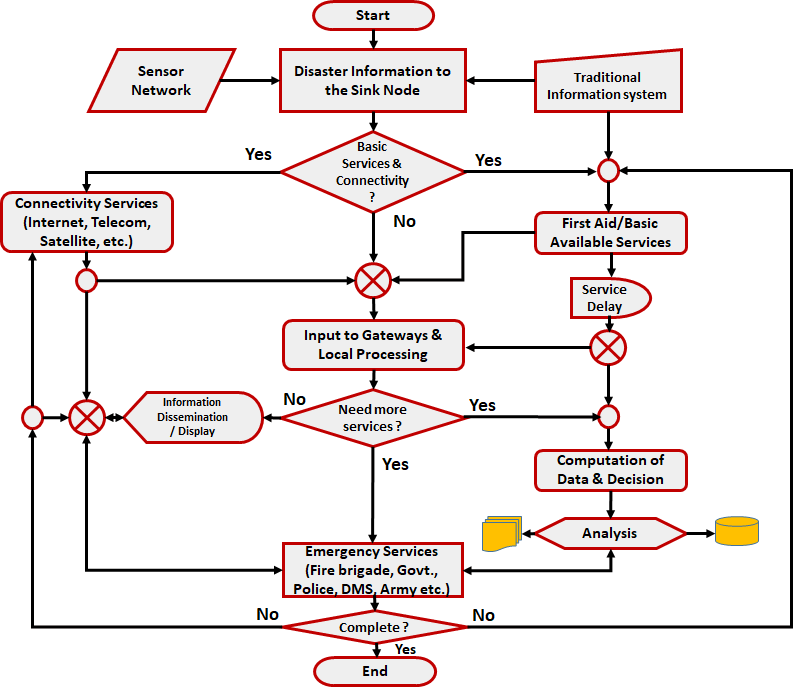Design and Development of High-Performance Intelligent Disaster Management System in IoT Paradigm-A Novel Architecture and Review on Challenges in Real Time Hazards Monitoring
Abstract
In recent years India is suffering from various natural disaster which have great effect on social life of people and large burden on disaster management authority. The high frequency disaster causes a serious loss of property, life and present more complex damage. Disaster management involves the detailed process of disaster response. A high-performance intelligent disaster management system can realize the complete disaster avoidance and reduction from satellite mission planning, data production, data acquisition, with the application of remote sensing and managing integrated rapid service. The main objective of proposed work is to overcome the limitations of disaster management with a novel design and development of IoT based platform for the application of disaster management system.
Keywords: IoT; Embedded system; Wireless sensor network; Sensors; Controllers; AI; ICT; E-governance; Smartcity; Smart village; GIS; Satellite
Keywords
Introduction
Nowadays, Internet of Things (IoT) is a emerging research area in the world. An IoT is a system of heterogeneous, multidisciplinary objects (physical and virtual) embedded with electronics, software, sensors/actuators, and network connectivity that enables these objects to collect and exchange data. IoT is also termed as internet of everything. It is an advanced automation, analytics and technology enabler system which exploits sensing, networking processing, Storing, big data, and Artificial Intelligence (AI) to deliver complete system for a product or service. IoT system allow greater transparency, control, and performance when applied to any system or industry shown in Figure 1.
In recent days, it has been suggested that more than 30 billion smart devices would be connected to each other via IoT by 2020. Many Governments around the globe are racing to infuse IoT technology to build smart operations in smart cities/villages. These modern cities, capable of implementing smart IoT based infrastructures such as highway surveillance, green house, pollution, traffic, transport, electricity, parking, people governance, water, gases, and disaster management. Other application such as communicating, sustainable in real time to improve citizens’ comfort while developing in the environmental protection. Also, IoT enabling technologies help to harvest energy and preserve natural resources [1].
Role of A Disaster Management System
A disaster is a sudden, calamitous event that seriously disrupts the functioning of a community or society and causes human, material, and economic or environmental losses illustrate the common natural disasters. We have already witnessed several of disasters all around the world costing lives of millions of living things and yet to see more in coming years. Natural and artificial disasters are the sudden events that require an immediate action by the stakeholders like. Information and communication technologies and smart cities plays a crucial role during Natural and artificial disasters phases. Effective and productive disaster management is the key aspect in disaster management scenario to save the lives of millions of dwellers trapped in such situations and provide necessary rehabilitation facilities to them. Disaster and disaster management is an important global problem and its need attention to build resilient system in urban and rural areas. In IoT paradigm: Smart city (Urban) technology infrastructure, service model and challenges needs to be addressed and smart rural framework to mitigate the effects of environmental conditions, agriculture, and flooding using IoT and the cloud services [2].
In developing countries like India, villages need to be smart. Efforts need to be taken to bring smartness in villagers. The activities in villages should be linked to smart cities to boost the parameter such as economy, transportation, communication, technology etc. In a country like India, where majority of population lives in villages. To make rural areas smart the existing infrastructure and services such as of urban areas needs to be upgraded to build smart villages. An IoT framework helps a bilateral flow of commodities like between rural and urban areas. There are several challenges to link the rural and urban stakeholders in real time situation such as, connectivity infrastructure emergency/disaster management.
Phases of Disaster/Emergency Management Cycle
Disaster management is tool used to reduce, avoid, or control the potential losses of living and non-living things. Various governmental, non-governmental organization and stakeholders are involved in disaster management cycle to reduce the impact of disaster. Appropriate action at all circumstances in cycle leads to, better warning, reduce and control the calamity. During this, multiple actors works in isolation includes public interest, government policies, recovery, mitigation, infrastructure development planning, and services. The IoT enabled services and ICT technology during disaster phases plays a vital role for shaping the policies, plan, cause and effect and mitigate the vulnerability and effect on inhabitant, property, and infrastructure. Prevention, mitigation, preparedness, response, and recovery are key elements of disaster/emergency management cycle [3]. Each phase during the emergency management are separate entity and surveyed the use of IoT and ICT technology. The insight of all four phases as during in disaster management systems are given below:
- Prevention focuses on preventing hazardous situation (Human and Natural) or terrorist (both physical and biological). The risk of loss of life and damage of property can be prevented by planning and design standards through enabling technologies such as ICT (IoT, Remote Sensing, satellite, GIS, Cloud. etc.).
- It is an important component in emergency. Preparedness is the readiness to respond in any emergency. It is continuous cycle to take corrective action.
- It is an important constituent during rescue. Often during rescue operation logistic coordination and distribution is the key requirement. Response phase aims to provide immediate assistance to the victims such as communication network, transport, food, shelter, medicine & emergency services.
- The purpose of the recovery is to bring the affected area back normalcy with the help of Govt., NGO, and restoration services in post disaster phase. But real time smart architecture is obligatory in intelligent disaster management, an IT platform, mobile network to provide services, data exchange and control the impact by disseminating situational information.
Methodology and Algorithm
Figure 2 shows the design and development plan for distinctive entities offering diverse services in the context of IoT. We explore the underlying technology in disaster management during response and recovery phase for rural and urban linkages. Scientific knowledge is vital for orchestrating disastrous situation in IoT outlook while modelling disaster resilient architecture. Roadmap of an IoT provides emergency and demanding services of any THING, at any TIME, and at any PLACE is very stimulating [4].
Scope of Work
Through IoT enabler’s data aggregation, processing, analysis, network capabilities and services expedite to develop an application while ensuring that security and privacy domains should fulfilled. To create an interactive environment in critical situation numerous challenges, need to be addressed in IoT space. The proposed study surveyed functionalities and components of emerging technology and its challenges at each layer of abstraction to implement an IoT ecosystem for disaster management. Figure 3 characterizes the post disastrous real time situation. Growth and complexities, intermittent, scalability of IoT network attracts a global infrastructure to enable advance services by interconnecting things based on existing and evolving interoperable ICTs. The functionality of the model is illustrated with the help of flowchart shown in Figure 4.
Let us consider catastrophe situation like flood is to be happened in village or city. A village is the remote place, where claiming and exchanging of information is the key challenge. Also, a city is deal with resources and availability of technology during footing of calamity. We estimated and granted IoT services and other technological support to provide optimum assistance in real time. Flooding information is generated through sensors, and it is sensed by sensor network which is already deployed in disaster prone area. The clue is received at the sink node deployed in the sensor area network. The Sink node can be embedded system dedicated to perception of physical parameters. The conventional information system can also regularly disseminate the messages to the sink node. The service request to the basic service available to the sink node. Further at the same time this is to be sent gateway from Layer 1 to Layer 2 for further action via communication medium.
Gateway (Or Local server) processed the data and take corrective action (Edge/Fog computing). If basic services cannot accomplish after specified time delay, service request should be initiated by gateways to adjacent disaster management or to the upper layer for more utilities. The high- volume data processing is done in layer 3 comprised of Artificial Intelligent (AI), cloud computing, and big data analysis, machine learning algorithms, mining, Graphical Information System (GIS), and storage technologies. After analysis, inferring, and decision; layer 4 offered additional integrated services to the layer 3. The applications and process in layer 4 administered and accounts a business value to save the inhabitants. Upper layer accomplished the IoT services like E-ambulance, amart transport, traffic management, smart governance, smart people, hospital, emergency services, disaster management services, smart mobility, police, NGOs, army and so on and so forth [5].
Challenges in Architectural Layer
Layer 1
- Smart devices and sensing layer is the sensor network of physical objects that contains sensors, controllers, wireless sensor networks, embedded technology to communicate and sense or interact with their internal states or the external environment.
- In real time situation Efficient, scalable and associated architecture are pivotal for disaster resilient Sensor network should be autonomous and an adaptive to the environment.
- IoT LAN (Local Area Network) configured for building sensor network. While organizing in LAN jurisdiction the components like Unambiguous naming and addressing, abundance of sleeping nodes, mobile and non-IP devices, energy efficiency, bandwidth management, large scale deployment, intermittent connectivity, mobility, coverage and maintenance of network needs to be addressed. Sensor cloud provides the solution to some extent.
Layer 2
- It can implement several LAN and WAN, Forwards packets between LAN and WAN on the IP Complexity of Networks (Growth of networks, Real‐time connectivity of billions of devices, Traffic and load management, Existence of malicious nodes, selfish node, Interference among devices, Network management, Interoperability, Heterogeneity in networks, mobility, Protocol standardization within networks) is the de facto while considering real time situation.
- Fog and Edge computing should have high Performance, accessibility, portability, cross platform communication, reduce data latency, better data handling and
- Fog challenges power consumptionFog use addition nodes, power consumption is higher than centralized Data security-data generating nodes are distributed, providing authentication and authorization system for the whole nodes is not an easy task.
- Reliability-maintaining data integrity and availability for millions of nodes is difficult. Real time analysis is a primary requirement for minimizing latency. Dynamic analysis and decision making reduces danger and increase output, monitor huge number of nodes is not easy. Also, these frameworks cannot provide proper scalability and
Layer 3
- IoT proxy performs active application layer functions between IoT nodes and other entities (security, modeling and analysis, interfacing, interoperability, data storage, big data analytics, complexity management, protocol standardization, IoT integration, real‐time solutions).
- In Cloud computing, cloud resources should be available over the network, should support standard mechanisms for information retrieval using traditional interfaces, should support Clients. Cloud resource allocation should be rapid, elastic, and automatic.
- Resource usage should be recorded and monitored, Facility to dynamically control and optimize the resource This facility should be transparent, available as a self- service between the service provider and consumer.
- Limitations (centralized control, switching cost, Limited flexibility, data security and privacy, authentication).
Layer 4
- The rescue is the challenging and critical Resource management needs dynamic techniques during recovery time. Proposed domain specific search engine for disaster information gathering.
- The search engine architecture collects heterogeneous data of various events. The simulation is done based on collected data and corrective action taken such as organize emergent resources and understand current damage and/or recovery status.
- Transfer, storage and maintenance of huge volumes of data is expensive. Data cleaning and purification is time consuming. Analytics on gigantic data volumes is processing intensive.
- Delay due to large scale deployments. Delay due to mobility of deployed nodes. Distribution of devices can affect monitoring tasks. Data fusion, data handling and analytics, imperfection, ambiguity, conflicts, alignment, trivial features. Standardization (interoperability, data semantics).
Conclusion
This paper presented the usefulness of underlying information and communication technologies for disaster management like flooding. The novel architecture for linkages of rural and urban for real time monitoring of calamities in the context of IoT enabled services is proposed. This paper studied the functionalities and services to build robust, intelligent and high-performance disaster resilient system. Therefore, it should implement IoT ecosystem for real time situation like flooding to saves a life of dwellers. This proposed work modeled the example of catastrophic situation like flooding happened in village. In remote places the exchanging of information is the key challenges. The novel layered architecture shows the various services involved like Govt. NGOs, Information, and technologies. During surveyed this literature proposed the challenges in layered architecture such as building sensor network, data aggregation, analysis, and real time decision. The fusion of fog computing, remote sensing and Artificial intelligent needs to be studied and is the future scope for design and development of resilient disaster management system.
Acknowledgment
Special thanks to Principal, Sardar Patel College of Engineering, Mumbai and Director, Walchand College of Engineering, Sangli for support and funding to publish research paper and Dr. S. M. Rathod, Assistant Manager, Defense-Research and Development, Bharat Forge, Kalyani Centre for Technology & Innovation, Pune for precious guidance and motivation to write a paper.
References
- Chun SM, Park JT (2017) A mechanism for reliable mobility management for internet of things using CoAP. Sensors 17: 136.
- Sookhak M, Akhundzada A, Sookhak A, Eslaminejad M, Gani A (2015) Geographic wormhole detection in wireless sensor networks. PLoS One 10: e0115324.
- Abdelaziz A, Fong AT, Gani A, Garba U, Khan S, et al. (2017) Distributed controller clustering in software defined networks. PLoS One 12: e0174715.
- Bartoli G, Fantacci R, Gei F, Marabissi D, Micciullo L, et al. (2013) A novel emergency management platform for smart public safety. Int J Commu Syst 28: 928-943.
- Hajjaj Y, Boulila W, Farah IR, Romdhani I, Hussain A, et al. (2021) Big data and IoT-based applications in smart environments: A systematic review. Comp Sci Rev 39: 100318.
Select your language of interest to view the total content in your interested language
Share This Article
Recommended Journals
Open Access Journals
Article Usage
- Total views: 2439
- [From(publication date): 0-2021 - Dec 14, 2025]
- Breakdown by view type
- HTML page views: 1781
- PDF downloads: 658




